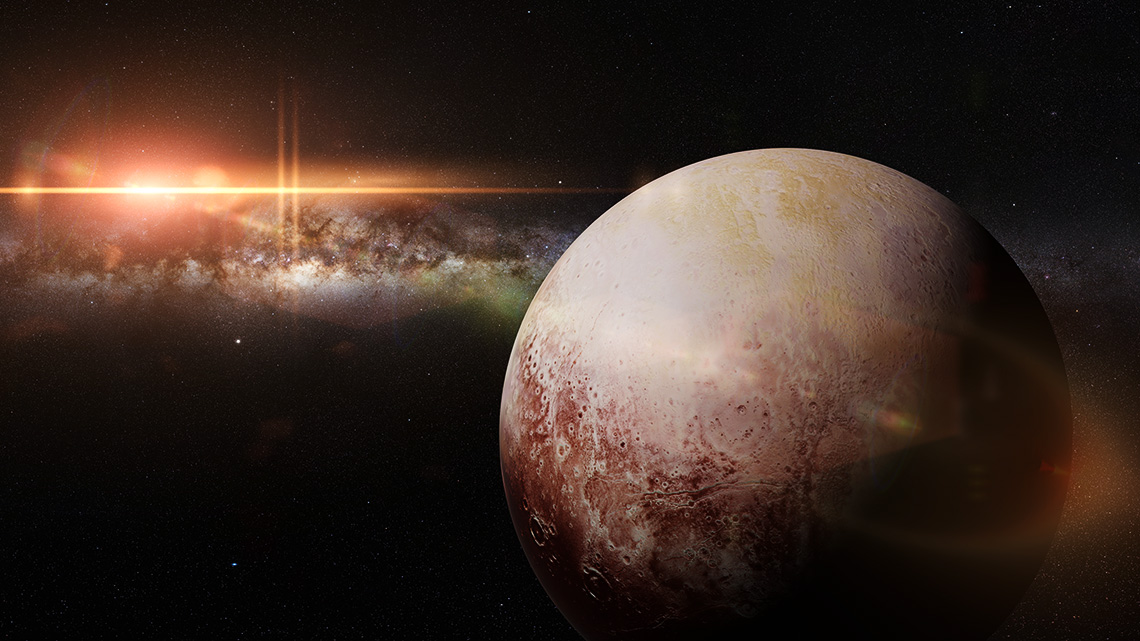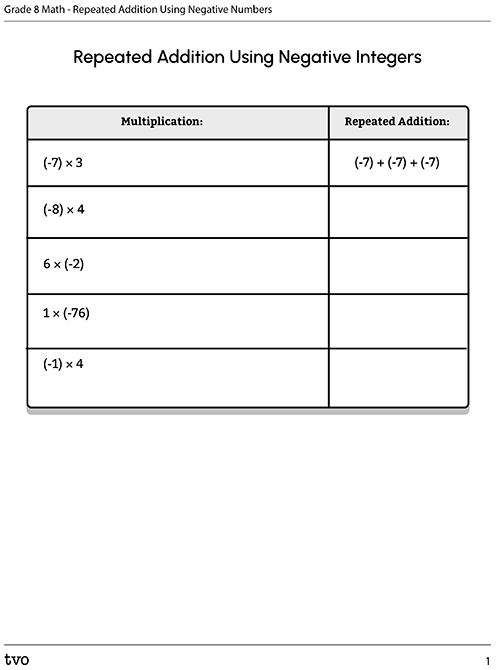Minds On
Integers and problem solving

The following is a table of the minimum and maximum surface temperatures of some planets in our solar system. For each planet, how could you determine the following?
- The difference between the minimum and maximum surface temperatures.
- The average surface temperatures.
| Planet | Minimum Surface Temperature (coldest it gets) | Maximum Surface Temperature (warmest it gets) |
|---|---|---|
| Mercury | −170 ℃ | 449 ℃ |
| Venus | −364 ℃ | 427 ℃ |
| Earth | −89 ℃ | 58 ℃ |
| Mars | −125 ℃ | 20 ℃ |
If you would like, you can complete this activity using TVO Mathify. You can also use your notebook or the following fillable worksheet.
Press the ‘TVO Mathify' button to access this interactive whiteboard and the ‘Activity’ button for your note-taking document. You will need a TVO Mathify login to access this resource.
TVO Mathify (Opens in new window) Activity (Open PDF in a new window)Action
Multiplying integers
Recall that an “integer” is a positive or negative whole number. We explored examples of integers in our chart of surface temperatures of different planets. We will revisit this later. For now, we are going to talk about multiplying and dividing integers.

Task 1: Multiplying a positive and a negative integer
When we multiply two numbers together, we are just doing repeated addition:
| Multiplication: | Repeated Addition: |
|---|---|
|
4 × 5 OR 5 × 4 |
5 + 5 + 5 + 5 OR 4 + 4 + 4 + 4 + 4 |
|
3 × 12 OR 12 × 3 |
12 + 12 + 12 OR 3 + 3 + 3 + 3 + 3 + 3 + 3 + 3 + 3 + 3 + 3 + 3 |
The same is true when one of the integers in negative. Since multiplication works in either order (for example 5 × 4 = 4 × 5), you can change the order so that you are always adding the negative integer. Complete Repeated Addition Using Negative Integers in your notebook or using the following fillable worksheet.

Press the Activity button to access the Repeated Addition Using Negative Integers.
Activity (Open PDF in a new tab)| Multiplication: | Repeated Addition: |
|---|---|
| 3 × (−7) | (−7) + (−7) + (−7) |
| (−8) × 4 | |
| 6 × (−2) | |
| 1 × (−76) | |
| (−1) × 4 |
Reflection
- What do you notice about the answers in the table?
- Is it always true that a positive integer times a negative integer is negative? Why or why not?
Task 2: Multiplying a negative integer by a negative integer
Using the idea of repeated addition no longer works when multiplying two negative integers. Consider this problem:
(−2) × (−3) = ?
We cannot add (−3) to itself “−2 times.” So how will this work? Make a prediction for how you think it might work and try to explain why your prediction is the appropriate method.
To answer this, consider this multiplication problem:
18 × 17 = 306
One way we understand how this multiplication works is by using a base-ten rectangle model (recall that the area of a rectangle is length × width):

The rectangle can be split into 4 sections:
10 × 10 = 100 (red)
10 × 8 = 80 (pink)
10 × 7 = 70 (pink)
7 × 8 = 56 (blue)
So 18 × 17 = 100 + 80 + 70 + 56 = 306.
But, what if instead of 18 we wrote 20 − 2 and instead of 17 we wrote 20 − 3:

20 × 20 = 400
20 × (−2) = −40
20 × (−3) = −60
(−3) × (−2) = ???
Add up what we know:
400 + (−40) + (−60) = (Blank)
This is supposed to be 17 × 18 = 306
So, what are we missing?
Therefore, (−3) × (−2) = (Blank)
Ever come across the expression: two wrongs don’t make a right? Well, that is not true when it comes to multiplying negative integers! Two “wrongs” (negatives) do make a right (positive). Two “wrongs” (negatives) do make a right (positive).
Test Your Skills!
Practice
Use multiplication strategies to work through these problems. Then, make sure each of your answers has the correct sign.
(−4) × (−3) =
(−8) × (−1) =
(−16) × (−10) =
(−1) × (−1) =
Reflection
Consider the following multiplication problems:
(−2) × (−2) × (−2) =
(−2) × (−2) × (−2) × (−2) =
(−2) × (−2) × (−2) × (−2) × (−2) =
What do you notice about the number of (−2)’s in each question and the sign of the answer?
Task 3: Dividing integers
Let's take a look at what happens when we multiply a positive integer by a negative integer in the following chart:
| (−12) = | (+4) × (−3) |
| (−9) = | (+3) × (−3) |
| (−6) = | (+2) × (−3) |
| (−3) = | (+1)× (−3) |
| 0 = | (0) × (−3) |
| (+3) = | (−1) × (−3) |
| (+6) = | (−2) × (−3) |
| (+9) = | (−3) × (−3) |
| (+12) = | (−4) × (−3) |
Describe the pattern in the chart
- how come when you multiply two negative numbers the product is a positive number?
Dividing with integers is similar to multiplying with integers. It follows the same type of pattern.
| (+4) = | (+20) ÷ (+5) |
| (+3) = | (+15) ÷ (+5) |
| (+2) = | (+10) ÷ (+5) |
| (+1) = | (+5) ÷(+5) |
| 0 = | (0) + (+5) |
| (−1) = | (−5) ÷ (+5) |
| (−2) = | (−10) ÷ (+5) |
| (−3) = | (−15) ÷ (+5) |
| (−4) = | (−20) ÷ (+5) |
Describe the pattern.
| Multiplication OR Division | Positive (+) | Negative (−) |
|---|---|---|
| Positive (+) | Positive (+) | Negative (−) |
| Negative (−) | Negative (−) | Positive (+) |
Try making your own chart by changing Positive (+) to an action or feeling you associate to something positive and similar for Negative (−).

Example:
| Multiplication OR Division | Love | Hate |
|---|---|---|
| Love | If you love to love, then you love | If you love to hate, then you hate |
| Hate | If you hate to love, then you hate | If you hate to hate, then you love |
Test Your Skills
Practice
Use division strategies to work through these problems. Then, make sure each of your answers have the proper sign.
15 ÷ (−3) =
(−56) ÷ (−8) =
(−45) ÷ (−1) =
72 ÷ (−1) =
Reflection
Consider the following six questions. What do you notice about the chart? What patterns do you find?
| Multiplication | Division |
|---|---|
| 5 × (−1) = | 5 ÷ (−1) = |
| 5 × (−1) × (−1) = | 5 ÷ (−1) ÷ (−1) = |
| 5 × (−1) × (−1) × (−1) = | 5 ÷ (−1) ÷ (−1) ÷ (−1) = |
Consolidation
Negative measurements
When would you need to multiply or divide integers in real life? Construct a list of examples when it might be needed.
When listing ideas, try to think of where negative measurements are taken (for example, temperature). Can you think of others?

Practice
Solve the following word problems. Be sure to explain your thinking for each problem and use the strategies you developed to multiply and/or divide integers.
- A submarine is resting at sea level. It starts to descend at a rate of 26 meters per minute. Where is the submarine after descending for 9.5 minutes?
-
Mr. X is designing a biology test for their students. The test has 30 multiple choice questions. Mr. X has
decided that students will be awarded 5 points for a correct answer, will lose 3 points for an incorrect
answer, and will lose 1 point for not answering the question. Here are
one student’s results:
- 20 questions correct
- 3 questions unanswered
- 7 questions incorrect
-
Arnie is an elevator repairperson working on a stuck elevator in a giant apartment complex. The apartment
marks its floors as follows:
… ∣ 3 ∣ 2 ∣ 1 ∣ G ∣ −1 ∣ −2 ∣ −3 ∣ …
The floors with negative numbers are the parking garage.
Arnie is currently working on the elevator on the 85th floor. Suddenly, the elevator starts to fall! Arnie watches the floors and quickly notices that the elevator is falling at a rate of 7 floors every 5 seconds. The parking garage goes to the -35th floor. How many seconds does Arnie have to fix the elevator before it crashes?
Build your own
- Construct your own word problem involving the multiplication and/or division of integers.
- Write a complete solution to your problem.
- If possible, share your problem with a partner or with someone at home and try to solve their problem. Alternatively, record the solution to your problem using your method of choice.
Reflection
As you read the following descriptions, select the one that best describes your current understanding of the learning in this activity. Press the corresponding button once you have made your choice.
I feel...
Now, expand on your ideas by recording your thoughts using a voice recorder, speech-to-text, or writing tool.
When you review your notes on this learning activity later, reflect on whether you would select a different description based on your further review of the material in this learning activity.
Press ‘Discover More’ to extend your skills.
Discover MoreA real problem
One measurement that is important for tracking climate change and the warming of the Earth is the Arctic sea ice minimum. This is the smallest area that the sea ice in the Arctic becomes each year. If the numbers continue to drop, more ice will permanently melt into the ocean, eventually leading to catastrophic changes in the Earth’s climate.

Here is the data for the Arctic sea ice minimum over the last 2 years:
| Year | Arctic sea ice minimum (in km²) |
|---|---|
| 2020 | 3,920,000 km² |
| 2019 | 4,360,000 km² |
By how much did the area of the sea ice go down by? Provide your answer in a negative number.
If the ice continued to melt by the amount it did between 2020 and 2019, in how many years would the sea ice minimum reach 0?
Here is the data from the past 7 years:
| Year | Arctic sea ice minimum (in km²) |
|---|---|
| 2020 | 3,920,000 km² |
| 2019 | 4,360,000 km² |
| 2018 | 4,790,000 km² |
| 2017 | 4,820,000 km² |
| 2016 | 4,530,000 km² |
| 2015 | 4,620,000 km² |
| 2014 | 5,220,000 km² |
Does the ice melt by the same amount each year? Why do you think this is the case?
Find the average change from 2015 to 2020.
Use a mathematical tool to graph this data. What do you notice about the graph? What do you wonder about this data?
Connect with a TVO Mathify tutor
Think of TVO Mathify as your own personalized math coach, here to support your learning at home. Press ‘TVO Mathify’ to connect with an Ontario Certified Teacher math tutor of your choice. You will need a TVO Mathify login to access this resource.
TVO Mathify (Opens in new window)